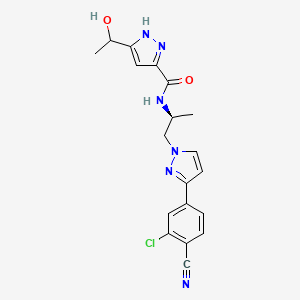



1. Nubeqa
2. Odm-201
3. Orm-16497
4. Orm-16555
1. Odm-201
2. 1297538-32-9
3. Bay-1841788
4. Nubeqa
5. Bay1841788
6. Darolutamide [usan]
7. N-((s)-1-(3-(3-chloro-4-cyanophenyl)-1h-pyrazol-1-yl)propan-2-yl)-5-(1-hydroxyethyl)-1h-pyrazole-3-carboxamide
8. Bay 1841788
9. X05u0n2rco
10. Odm-201;bay-1841788
11. 1h-pyrazole-3-carboxamide, N-((1s)-2-(3-(3-chloro-4-cyanophenyl)-1h-pyrazol-1-yl)-1-methylethyl)-5-(1-hydroxyethyl)-
12. N-((s)-1-(3-(3-chloro-4-cyanophenyl)-1h-pyrazol-1-yl)-propan-2-yl)-3-(1-hydroxyethyl)-1h-pyrazole-5-carboxamide
13. Odm201
14. 1h-pyrazole-3-carboxamide, N-[(1s)-2-[3-(3-chloro-4-cyanophenyl)-1h-pyrazol-1-yl]-1-methylethyl]-5-(1-hydroxyethyl)-
15. Nebeqa (tn)
16. Darolutamide [mi]
17. Odm-201(darolutamide)
18. Darolutamide [inn]
19. Darolutamide [jan]
20. Unii-x05u0n2rco
21. Darolutamide (odm-201)
22. Darolutamide [who-dd]
23. Darolutamide (jan/usan/inn)
24. Schembl1814935
25. Chembl4297185
26. Schembl13733117
27. Gtpl10439
28. Ex-a759
29. Bdbm309979
30. Darolutamide [orange Book]
31. Dtxsid101027953
32. Example 56 [us9657003]
33. N-[(2s)-1-[3-(3-chloro-4-cyanophenyl)pyrazol-1-yl]propan-2-yl]-5-(1-hydroxyethyl)-1h-pyrazole-3-carboxamide
34. Bdbm50556205
35. Mfcd29472270
36. Nsc825331
37. Akos030526387
38. Ccg-268640
39. Cs-5174
40. Db12941
41. Nsc-825331
42. Ncgc00484078-01
43. Ac-32628
44. As-75032
45. Bay-1841788)
46. Hy-16985
47. S7559
48. J3.501.129c
49. D11045
50. Us9657003, 56
51. A888821
52. J-690121
53. Q25091391
54. 1-[(2s)-2-butanyl]-n-[(4,6-dimethyl-2-oxo-1,2-dihydro-3-pyridinyl)methyl]-3-methyl-6-[6-(1-piperazinyl)-3-pyridinyl]-1h-indole-4-car Boxamide
55. N-((2s)-1-(3-(3-chloro-4-cyanophenyl)-1h-pyrazol- 1-yl)propan-2-yl)-5-((1rs)-1-hydroxyethyl)-1h-pyrazole- 3-carboxamide
56. N-((2s)-1-(3-(3-chloro-4-cyanophenyl)-1h-pyrazol-1-yl)propan-2-yl)-5-((1rs)-1-hydroxyethyl)-1h-pyrazole-3-carboxamide
57. N-((s)-1-(3-(3-chloro-4-cyanophenyl)-1h-pyrazol -1-yl)propan-2-yl)-3-(1-hydroxyethyl)-1h-pyrazole-5-carboxamide
58. N-((s)-1-(3-(3-chloro-4-cyanophenyl)-1h-pyrazol-1-yl)propan-2-yl)-5-(1-hydroxy-ethyl)-1h-pyrazole-3-carboxamide
59. N-[(2s)-1-[3-(3-chloro-4-cyanophenyl)-1h-pyrazol-1-yl]propan-2-yl]-5-(1-hydroxyethyl)-1h-pyrazole-3-carboxamide
| Molecular Weight | 398.8 g/mol |
|---|---|
| Molecular Formula | C19H19ClN6O2 |
| XLogP3 | 1.8 |
| Hydrogen Bond Donor Count | 3 |
| Hydrogen Bond Acceptor Count | 5 |
| Rotatable Bond Count | 6 |
| Exact Mass | 398.1258016 g/mol |
| Monoisotopic Mass | 398.1258016 g/mol |
| Topological Polar Surface Area | 120 Ų |
| Heavy Atom Count | 28 |
| Formal Charge | 0 |
| Complexity | 598 |
| Isotope Atom Count | 0 |
| Defined Atom Stereocenter Count | 1 |
| Undefined Atom Stereocenter Count | 1 |
| Defined Bond Stereocenter Count | 0 |
| Undefined Bond Stereocenter Count | 0 |
| Covalently Bonded Unit Count | 1 |
This drug is indicated for the treatment of patients diagnosed with non-metastatic and castrate-resistant prostate cancer.
FDA Label
Nubeqa is indicated for the treatment of adult men with non metastatic castration resistant prostate cancer (nmCRPC) who are at risk of developing metastatic disease.
Darolutamide, through its downstream effects on cancer cell growth, treats castrate-resistant prostate cancer. It inhibits cancer cell growth and markedly lowers prostate specific antigen (PSA) levels through potent androgen receptor antagonism.
L02BB
L - Antineoplastic and immunomodulating agents
L02 - Endocrine therapy
L02B - Hormone antagonists and related agents
L02BB - Anti-androgens
L02BB06 - Darolutamide
Absorption
Darolutamide is absorbed in the gastrointestinal tract. In the fasted state, peak concentrations are reached within 3-5 hours, and within 3-8 hours in the fed state. Median Tmax is between 3-6 hours.The average darolutamide steady-state peak plasma concentration after a 600 mg twice daily dose is approximately 4.79 mg/L. The Cmax is attained approximately 4 hours after administration of a single 600 mg oral dose. The AUC 0-12h is approximately 52.82 hg/mL. **Effects of food** The absolute bioavailability of darolutamide is approximately 30% after fasting and taking a single 300 mg dose. Steady-state concentrations are attained between 2 and 5 days after repeated administration with food. The bioavailability of darolutamide increases by 2.0 to 2.5 times when it is given with food.
Route of Elimination
In a pharmacokinetic study, a radiolabeled dose of darolutamide in an oral solution showed that 63.4% of darolutamide-related material was excreted in the urine (7% of which was unchanged drug) and 32.4% in the feces (with 30% unchanged drug).
Volume of Distribution
After intravenous administration, the apparent volume of distribution of darolutamide is about 119L.
Clearance
The clearance of darolutamide after an intravenous dose is 116 mL/min (39.7%).
Darolutamide is mainly metabolized by the CYP3A4 hepatic microsomal enzyme in addition to UGT1A9 and UGT1A1. The main active metabolite keto-darolutamide in found in the plasma at 2 times the concentration of darolutamide.
The half-life of darolutamide and its active metabolite, keto-darolutamide is about 20 hours. A phase 1 study determined a terminal half life ranging between 10-15 hours.
The actions of androgens on androgen receptors (AR) potentiate the growth and survival of prostate cancer cells. Darolutamide competitively inhibits androgens from binding to their receptors, inhibiting AR nuclear translocation, as well as AR-mediated transcription. The end result of these processes is a decrease in prostate cancer cell proliferation and tumor size. Its main metabolite, keto-darolutamide, shows similar pharmacological activity to the parent drug, darolutamide. Darolutamide has been found to bind more tightly to the AR receptor than [apalutamide] and [enzalutamide], which are other androgen receptor antagonists. Darolutamide can act as a progesterone receptor (PR) antagonist in the laboratory setting with approximately 1% activity when compared to its actions at the androgen receptor. The clinical relevance is not known at this time.

